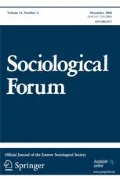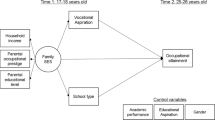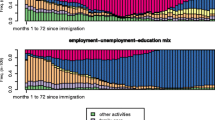Abstract
This study investigates immigrant-native differences in the activities of adolescents 2 years after their sophomore year of high school. We employ longitudinal data for the modeling of duration, nativity and generation differences in education and employment activities during late adolescence. We ask if the same human and social capital characteristics employed as explanations for nativity differences in achievement are predictive of high school participation versus other activities such as labor force participation within a cohort of adolescents. Despite their lower levels of human capital and lower previous academic performance, recent immigrants who arrive in the United States as adolescents are more likely than those who arrive earlier or those born in the United States to persevere in high school. Access to familial social capital and attitudinal measures help explain some of this effect. As for those who do leave school early, socioeconomic status and language background play a role in the activities respondents pursue. While recent immigrants are more likely to persevere in high school, once they leave they are no more likely to pursue additional education than their U.S. born counterparts.
Similar content being viewed by others
References
Alexander, Karl L., Doris R. Entwisle, and Maxine S. Thompson 1987 “School performance, status relations, and the structure of sentiment: Bringing the teacher back in. ” American Sociological Review 52:665–82.
Astone, Nan Marie, Constance A. Nathanson, Robert Schoen, and Young J. Kim 1999 “Family demography, social theory, and investment in social capital. ” Population and Development Review 25(1):1–31.
Astone, Nan Marie and Sara S. McLanaha 1994 “Family structure, residential mobility and school dropout. ” Demography 31(4):575–84.
Bankston, Carl L. III, Stephen J Caldas, and Min Zhou 1997 “The academic achievement of vietnamese american students: Ethnicity as social capital. ” Sociological Focus 30(1):1–16.
Bean, Frank D., Jennifer V.W. Van Hook, and Jennifer E. Glick 1997 “Country of origin, type of public assistance, and patterns of welfare recipiency among U.S. immigrants and natives. ” Social Science Quarterly 78:432–51.
Bourdieu, Pierre 1984 Distinction: A Social Critique of the Judgement of Taste. Cambridge: Harvard University Press.
Caspi, Avshalom, Bradley R. Entner Wright, Terrie E. Moffitt, and Phil A. Silva 1998 “Childhood predictors of unemployment in early adulthood. ” American Sociological Review 63(3):424–51.
Coleman, James 1990 Foundations of Social Theory. Cambridge, MA: Belknap Press of Harvard University Press.
Coleman, James S. and Thomas P. Hoffer 1987 Public and Private Schools. NewYork: Basic Books.
Coleman, James S., Thomas P. Hoffer, and Sally B. Kilgore 1982 High School Achievement. NewYork: Basic Books.
Fernandez-Kelly, M. Patricia and Richard Schauffler 1994 “Divided fates: Immigrant children in a restructured U.S. economy. ” International Migration Review 28:662–89.
Fix, Michael and Wendy Zimmerman 1994 “AfteraArrival: An overview of federal immigrant policy in the U.S.” In Barry Edmonston and Jeffrey S. Passel (eds.), Immigration and Ethnicity: The Integration of America's Newest Arrivals. 251–285. Washington, D.C.: Urban Institute Press.
Hagen, John, Ross MacMillan, and Blair Wheaton 1996 “New kid in town: Social capital and the life course effects of family migration on children. ” American Sociological Review 61(3):368–85.
Kao, Grace 1995 “Asian Americans as model minorities? A look at their academic performance. ” American Journal of Education 103:121–59.
Kao, Grace and Marta Tienda 1995 “Optimism and achievement: The educational performance of immigrant youth. ” Social Science Quarterly 76(1):1–19.
Kibira, Nazli 1994 “Household structure and family ideologies: The dynamics of immigrant economic adaptation among Vietnamese refugees. ” Social Problems 41(1):81–96.
Lareau, Annette 1989 Home Advantage: Social Class and parental Intervention in Elementary Education. New York: The Falmer Press.
Lindholm, Kathryn J. and Zierlein Acla 1991 “Bilingual proficiency as a bridge to academic achievement: Results from bilingual/immersion programs. ” Journal of Education 173:99–114.
Mouw, Ted and Yu Xie 1999 “Bilingualism and the academic achievement of first-and second generation Asian Americans: Accommodation with or without assimilation. ” American Sociological Review 64(2):232.
Murnane, Richard J., John B. Willet, and Kathryn Parker Boudett 1997 “Does acquisition of a GED lead to more training, post-secondary education and military service for school dropouts?” National Bureau of Economic Research Working Paper #5992.
Portes, Alejandro 2000 “The Two Meanings of Social Capital. ” Sociological Forum 15(1):1–12.
Portes, Alejandro and Dag MacLeod 1996 “Educational progress of children of immigrants: the roles of class, ethnicity and school context. ” Sociology of Education 69:255–75.
Portes, Alejandro and Zhou, M. 1993 “The new second generation: Segmented assimilation and its variants. ” The Annals of the American Academy of Political and Social Science 530:74–96.
Roscigno, Vincent J. 1998 “Race and the reproduction of educational disadvantage. ” Social Forces 76(3):1033–60.
Rumbaut, Ruben G. 1997 “Ties that bind: Immigration and immigrant families in the United States. ” In Alan Booth, Ann C. Crouter, and Nancy Landale (eds.), Immigration and the Family: Research and Policy on U.S. Immigrants. Mahwah, NJ: Lawrence Erlbaum Associates.
Rumbaut, Ruben G. 1996 “The New Californians: Assessing the educational progress of children of immigrants. ” California Policy Seminar Brief 8(3).
Rumbaut, Ruben G. 1994 “The crucible within: Ethnic identity, self-esteem and segmented assimilation among children of immigrants. International Migration Review 28:748–94.
Rumberger, Russell W. 1995 “Dropping out of middle school: A multilevel analysis of students and schools. ” American Educational Research Journal 32(3):583–625.
Smith, James P. and Finis Welch 1986 Closing the Gap: Forty Years of Economic Progress for Blacks. Santa Monica, CA: Rand Corporation.
Stanton-Salazar, Ricardo D. 1997 “A social capital framework for understanding the socialization of racial minority children and youths. ” Harvard Educational Review 67(1):1–40.
Tienda, Marta 1980 “Familism and Mexican immigrants in the United States. ” International Migration Review 14:383–405.
Trueba, Henry 1988 “Culturally based explanations of minority groups' academic achievement. ” Anthropology and Education Quarterly 19:270–287.
Valenzuela, Angela and Sanford M. Dornbusch 1994 “Familism and social capital in the academic achievement of Mexican origin and Anglo adolescents. ” Social Science Quarterly 75(1):18–36.
Vernez, Georges, and Allan Abrahamse (w/ Denise Quigley) 1996 How Immigrants Fare in U.S. Education. Santa Monica, CA: Rand.
Waters, Mary C. 1997 “Immigrant families at risk: Factors that undermine chances for success. ” In Alan Booth, Ann C. Crouter, and Nancy Landale (eds.), Immigration and the Family: Research and Policy on U.S. Immigrants. Mahwah, NJ: Lawrence Erlbaum Associates.
White, Michael J. 1997 Language Proficiency, Schooling, and the Achievement of Immigrants. Report to the U.S. Department of Labor.
White, Michael J. and Jennifer E. Glick 1998 “Nativity, family background and achievement in high school. ” Paper presented at the 93rd Annual Meeting of the American Sociological Association, San Francisco, CA.
Wong, Morrison 1990 “The education of White, Chinese, Filipino and Japanese students: A look at 'High school and beyond'. ” Sociological Perspectives 33:355–74.
Zhou, Min 1997a “Segmented assimilation: Issues, controversies and recent research on the new second generation. ” International Migration Review 31(4):975–1008.
Zhou, Min 1997b “Social capital in Chinatown: The role of community-based organizations and families in the adaptation of the younger generation. ” In Ch 9 Seller, Maxine and Lois Weis (eds.), Beyond Black and White: New Faces and Voices in U.S. Schools. Albany NY: SUNY Press.
Zhou, Min and Carl L. Bankston III 1994 “Social capital and the adaptation of the second generation: The case of Vietnamese Youth in New Orleans. ” International Migration Review 28(4):775–799.
Author information
Authors and Affiliations
Rights and permissions
About this article
Cite this article
White, M.J. Generation Status, Social Capital, and the Routes Out of High School. Sociological Forum 15, 671–691 (2000). https://doi.org/10.1023/A:1007515100190
Issue Date:
DOI: https://doi.org/10.1023/A:1007515100190




